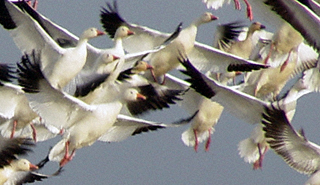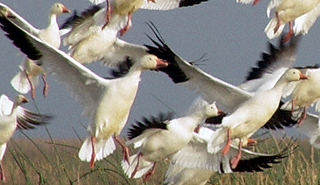Vertebrate Flight
THE EVOLUTION OF FLIGHT (a.k.a. HOW TO WING IT)
Perhaps the most perplexing and controversial aspect of the study of flight is the study of how and why flight evolved. Since flight evolved millions of years ago in all of the groups that are capable of flight today, we can't observe the changes in behavior and much of the morphology that the evolution of flight involves. We do have the fossil record, though, and it is fairly good for the three main groups that evolved true flight.
We'll spare you an in-depth description of how each group evolved flight for now; see the later exhibits for a description of each group and how they developed flight. The most amazing fact about the evolution of flight is the extent of convergent evolution between the three main groups that evolved it (again, the pterosaurs, birds, and bats). In this convergence, we can see some semblance of general "rules" that may govern how animals evolve flight, and from these rules we can perhaps glean a hint of what it takes for an animal to have potential for flight.
Flight Origins: How and Why?
The most difficult question about the origin of flight is "Why?". "Why" questions are the most difficult ones to ask when they concern evolution; evolution does not ask "why?" Evolution has no sense of future; the here and now is the only place where evolution occurs. It is imperative to keep this in mind when considering the origin of flight. Lineages of organisms are not designed for some future purpose; they are changed by opportunities to which they can respond and by the selective processes that their environment imposes on them. Evolution is limited by developmental and genetic constraints. If an adaptation is useful to a lineage, chances are that it will be preserved. If an adaptation is co-opted from a previous use to a new use, it is called an exaptation. The only scientific way to approach why flight evolved in a group is to first figure out how it evolved; what the temporal sequence of exaptations and adaptations was.
|
How flight evolved in a group depends on what its ancestors were doing (their behavior) and what they could do (their adaptations). Since all we have is the fossil record, which seldom preserves records of complex behavior (except animal tracks!), it becomes necessary to formulate hypotheses of ancestral behavior based on ancestral adaptations. |
|
 |
 Snow Geese. |
|
Translation: We must compare and contrast the structure of the ancestor of the flying lineage (or closest approximation thereof) with the earliest known member of that flying lineage (as determined by cladistics), using functional morphology to infer the possible function of the adaptations present in the earliest flyers, and then make predictions of possible behavior. The environment where the organism is found also helps |
In summation, to understand the evolution of a flying lineage, we must follow these steps in this order: (1) Understand the phylogeny of that group; what its origins were. (2) Understand the functional morphology relevant to flight, and how that changed from the nonflying ancestor to the earliest flyer. (3) Accumulate empirical evidence explaining how flight evolved, using such tools as aerodynamic analyses, ichnology (the study of fossilized tracks), and paleoenvironmental assessments. And finally (4) formulate an evolutionary hypothesis proposing why flight evolved in that lineage, supported by and consistent with all of the evidence from the previous three steps.
If our study of functional morphology determines that the ancestor of a flying group must have been a glider, and we think that it was arboreal (like all modern non-aquatic gliders) then flight must have evolved from an arboreal gliding ancestor. If we have fossilized tracks of our probable ancestor, then we can tell how it was moving on the ground (see our dinosaur speeds site for more information). If we figure out that the probable ancestor of a flying group was a bipedal cursorial (running) form, then flight likely evolved from the ground up. More about this in the next exhibit.
How and Why Did Wings Evolve?
Before we can answer how and why flight evolved, we must understand how and why wings evolved; without wings there can be no flight. How did wings evolve? Scientists generally agree that wings must have been exaptations; they were used by the ancestor for one function, and became useful for flight among the descendants (if they weren't exaptations, then they were adaptations, which would mean that they were wings already used for powered flight; a circular argument).
A comparative study of the functional morphology of the wings of the earliest known flying members of the lineage with the "pre-wing" structures of likely ancestors and close relatives provides the best evidence for how wings evolved. Why wings (and hence flight) evolved from this point is a matter of contention among scientists; various hypotheses proposed include:
- Wings evolved from arms used to capture small prey. (This seems rational, so we can ask whether the ancestral forms were actually doing this.)
Wings evolved because bipedal animals were leaping into the air; large wings assisted leaping. (This is possible; any amount of wing could assist leaping. Remember that we first need phylogenetic evidence for a bipedal running or leaping origin.)
Wings were used as sexual display structures; bigger wings were preferred by potential mates. (This is a non-falsifiable evolutionary hypothesis — we cannot test it.)
Wings evolved from gliding ancestors who began to flap their gliding structures in order to produce thrust. (This is reasonable and possible, but only with phylogenetic evidence for an arboreal gliding origin.)
It seems that #1, #2, and #4 are the best hypotheses to use for the origin of wings because they can be tested by bringing in other lines of evidence. Move on to consider these origins, but remember: the issues of the evolution of flight and the origins of flight are inextricably linked.
Next: The Origins of Flight